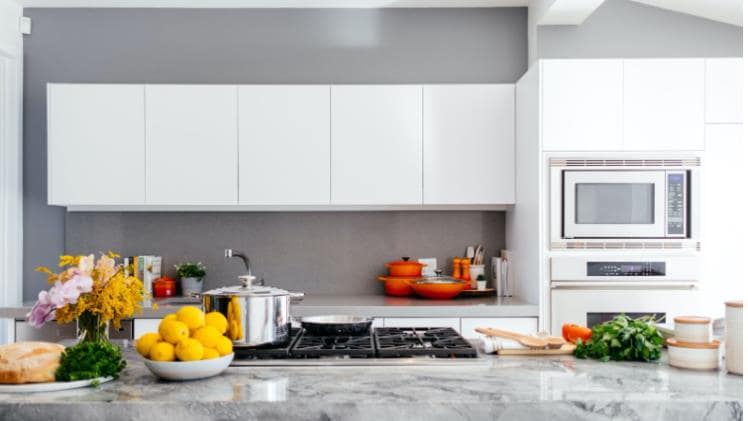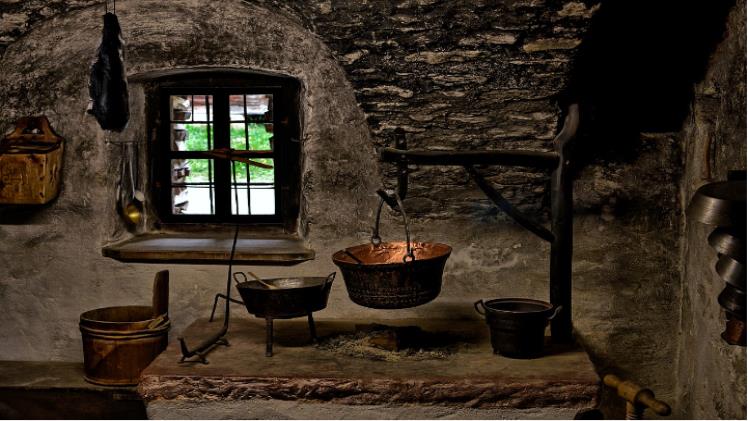Have you ever thought of cooking without electricity or running water? Kitchens in the past required a lot of physical labor just to get the cooking process started. Our forefathers would cook on an open fire outside all year, despite the weather. Some people would happily cook in the fireplace, reducing work and increasing efficiency by utilizing the heat for both purposes.
The modern kitchen has always been the most integral and practical in kitchen history. The origin of kitchen design is based on convenience and innovation rather than kitchen decor. Maybe we should begin by remembering that kitchens are a relatively new idea in terms of a room linked to our homes.
Kitchens from the late 1800s and early 1900s are where we first see the modern kitchen. Residential electricity and indoor plumbing were the norms by the early 1900s. Industrialization ushered in a new era in kitchen design evolution. Factory-made fixtures, modern appliances, and storage units were introduced.
Evolution of Kitchen Products

The kitchen products we now enjoy didn’t appear from thin air. Our predecessors performed kitchen activities in more strenuous ways. Here are some kitchen products and the history behind them.
Cheese and Charcuterie Boards
These boards have existed for hundreds of years. It wasn’t until later that America succumbed to the trend. Charcuterie is the artful preparation and arrangement of cured meats and other meat products. Recently, the term has come to refer to a variety of meats served with a variety of accompaniments such as fruit, cheese crackers, etc.
Salting and smoking meats for preservation purposes dates back approximately 6,000 years to ancient Rome. Charcuterie is based on the idea that no part of an animal should be wasted. The charcuterie board was invented by the French using offal and other types of meat. The traditional charcuterie board, on the other hand, has come a long way and is becoming increasingly popular on modern fine-dining restaurant menus.
Present-day cheese boards and charcuterie boards now serve multi-purpose. Boards from Lynnliana can both display food and add to your kitchen decor. Modern cheese boards range from wood designs to resin, bamboo, etc.
Pots
Pottery has been dated back at least 30,000 years. The first pottery and ceramic objects date back to 29,000 years ago. Humans utilized clay cooking pots before people worked with aluminum and copper pans. Such equipment was used by the ancient Greek empires.
The Greeks often cooked fresh foods in hot containers buried underground. This had an equivalent effect on modern-day cooking equipment because slow cooking allows food to be cooked for an extended period of time at a low temperature. This is now reminiscent of common cooking methods in modern times.
The dishes are prepared by slowly cooking them in covered pots over hot coals. Slow clay pot cooking was a technique used by ancient indigenous American tribes. This tradition gave birth to the iconic American barbeque.
Blenders
People had to disintegrate and mix things by hand prior to the development of the blender as an appliance. The mortar and pestle existed before blenders and mixers made kitchen work easier. The mortar and pestle, which is still widely used today, is thought to have been invented around 35,000 years ago.
The device, which is typically made of stone, ceramic, or wood, consists of a simple club-like shape and a rounded edge bowl into which ingredients can be ground or mashed. Early blenders were simply cups with spinning blades at the base, but newer blenders have all the technology in the world.
Refrigerator
Our refrigerators are finely crafted pieces of technology that are essential in the modern kitchen. The use of devices to keep things cold dates back centuries, but the advanced refrigerator began as an icebox in the early 1900s. These metal boxes were lined with a tin-like metal and then packed with a large ice block that slowly melted while keeping the food in the box cold.
These early ice boxes served their purpose, but by 1915, electric refrigerant-style refrigerators began to appear in homes all over the world. These early machines worked on the same principle as modern machines, cooling by using a refrigerant.
These early devices, known as Domeires, however, used a series of highly toxic gases as refrigerants. Near the end of WWII, manufacturers began using Freon in refrigerators. Tetrafluoroethane is now used in refrigerators to keep food cold.
Coffee Maker
Coffee as a beverage dates to the 15th century. These early drinkers muddled the beans with water and drank it to stay awake. However, the industrial revolution made simple routine tasks easier. Such manual methods become increasingly unfavorable.
The percolator, which first appeared in the 1860s, was the first machine-like appliance used to make coffee. This coffee-making technique evolved until the 1920s. Vacuum cleaners were introduced, and coffee makers included pump and filtering systems. This invention aided in the spread of coffee’s popularity among industrialized populations.
Kettles
Kettles are products that did not require a lot of advancement to bring them into the contemporary age. Early kettles were simply metal pots placed over gas stoves. By the 1890s, the world had an electric kettle that could heat water simply by being plugged in.
Following this breakthrough, kettle designs were essentially just gradually improved upon, as even the most advanced kettle technology available today is still simply an electric kettle.
Stoves
Cooking before the modern stove required the use of fire. Early stoves were simply metal containers that held burning wood and directed heat to a cooking surface. The first gas-powered stove was introduced in 1900.
For nearly three decades, gas dominated the stove industry until electric ovens were introduced as a safer and easier alternative. Stoves began to evolve from purely functional pieces of art into modern aesthetic works of art
Conclusion
From the times of preparing food over an open flame, the kitchen has evolved a great deal. High-tech gadgets and appliances in today’s kitchens make food preparation more attainable and efficient. While some may bemoan the loss of traditional cooking methods, there’s no denying that modern kitchens are much more convenient and inviting than ever before.
